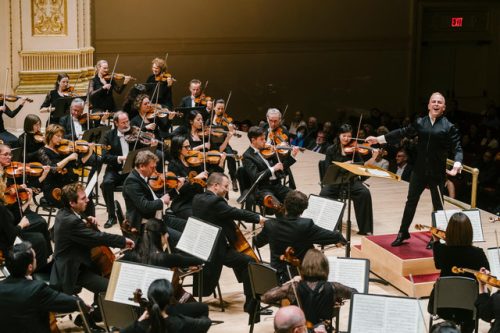 United States Brahms: Staatskapelle Berlin / Yannick Nézet-Séguin (conductor). Carnegie Hall, New York, 1.12.2023. (RP)
United States Brahms: Staatskapelle Berlin / Yannick Nézet-Séguin (conductor). Carnegie Hall, New York, 1.12.2023. (RP)

Brahms – Symphony No.3 in F major, Op.90; Symphony No.4 in E minor, Op.98
It was a week of twists and turns for two of New York’s great musical organizations. First, Daniel Barenboim withdrew from two highly anticipated, all-Brahms concerts with the Staatskapelle Berlin at Carnegie Hall with just over a week’s notice. Climate activists disrupted a performance of Wagner’s Tannhäuser at the Metropolitan Opera, making headline news. By contrast, tenor Juan Diego Flórez announcing that he was recovering from a cold barely caused a ripple at his Carnegie Hall recital (review here).
For all concerned, the eighty-one-old Barenboim’s cancellation was sad news. Earlier in the year, health issues had forced his resignation as music director of the Staatskapelle, which he had led since 1992. Health now caused him to cancel the orchestra’s North American tour to Chicago (where he had served as music director from 1991 to 2005), Toronto, Philadelphia and New York.
Yet again, it was Yannick Nézet-Séguin who saved the day. He is Carnegie Hall’s go-to conductor when crisis strikes, which it has with disconcerting regularity in recent years. He was also on board to conduct the Staatskapelle in Philadelphia, where he is in his twelfth season as music and artistic director for The Philadelphia Orchestra.
This was the second of two concerts of the Staatskapelle’s complete Brahms symphony cycle. The evening before, Nézet-Séguin had led them in Symphonies Nos. 1 and 2. Despite his not having worked with the Staatskapelle in recent years, there was nothing tentative or unpolished from either the conductor or the orchestra in this concert. The goodwill of the orchestra was decidedly a factor: there were smiles on the faces of the string players throughout the performance.
What impressed before a note was played was the size of the Staatskapelle Berlin string section. The placement of the lower strings to the conductor’s left was a bit out of the norm and resulted in a marked sonic difference from what is normally heard in the hall. The resulting additional warmth and body to the overall string sound suited Brahms to a tee.
Brahms composed his Third Symphony in 1883 in just four months. It was a remarkably speedy effort for the fastidious composer, even more so since it had been six years since he had completed his Second Symphony.
The symphony also found him in uncommonly high spirits – he has the woodwinds playing the musical cipher of his motto ‘Frei aber froh’ (‘Free but happy’) in the first measures. Brahms obviously intended it as a rebuke to violinist Joseph Joachim’s acid-spiked reformulation of the motto as ‘Frei aber einsam’ (‘Free but lonely’) to describe the never-wed composer.
In the first movement of the symphony, after graceful playing from the woodwinds, Nézet-Séguin drew wonderful waves of sound, full of excitement and energy, from the orchestra. The second movement was defined by the depth and richness of the horn playing and the graceful melodies in the winds, which ended soft and sublime.
A somber mood was cast by the cellos playing of one of Brahms’s best-known melodies in the third movement. It showed Nézet-Séguin at his lyrical best as he wrung emotion out the music through his sensitive phrasing. In the lyrical, passionate finale, the shimmering playing of the strings faded into nothingness in the final measures.
Brahms Fourth Symphony, composed during the summers of 1884 and 1885, is among the darkest works in the canon. It is nonetheless considered the composer’s finest, due chiefly to it being the most personally revealing and architecturally complex of his four symphonies.
Nézet-Séguin led a dramatic reading of the first movement, notable for the brilliance of the violin sound. In the second movement, the horn playing over pizzicato strings was remarkably fine. As the movement progressed, it became faster and darker.
The Allegro giocoso was equally dramatic but ever so much lighter in mood and texture. Humor was injected by the addition of piccolo and triangle to the orchestra’s colors. Slashes of brass fanfares alternated with softer passages in which the string sound was especially vibrant.
An explosion of sound and energy launched the finale. The fugal sections were flowing and fast, with the articulation of the theme by the violins particularly clear and precise. The prevailing emotion as the movement progressed was terror, which was only released by the roll of the timpani echoing through the hall at the end of this brilliant and brave performance.
Rick Perdian

Comment received from Gustavo Benavides on the concert that took place in Philadelphia on December 3, 2023: To say that there was urgency in Yannick Nézet-Séguin’s Brahms would be an understatement: the luminous opening of the Third Symphony sounded like a concerto for tam-tam and orchestra, while the gravitas, melancholy and sense of inevitability of the Fourth were replaced by frenzy and vulgarity. I have seldom left a concert in such a bad mood though I may add also that the orchestra played splendidly and did, alas, everything N-S asked them to do.
.